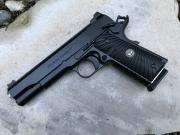The gas system of the AR is controlled to my knowledge by several components:
The ammo generates a certain amount of PSI.
The size of the gas port in the barrel is open to allow a certain amount of gas back.
The gas block may impact gas?? Or only if itís an adjustable gas block?
The length of the gas tube controls the speed of the gas.
The weight of the bolt carrier slows down the gas.
The weight of the buffer slows down the gas.
The flexibility and length of the buffer spring slows down the gas.
Of those, the easiest to modify are the buffer and the buffer spring. For an enthusiast who has several ARs, it seems cost reasonable to buy one of each buffer and buffer spring and do some testing.
And then use the combination that results in the ďbestĒ outcome.
My question is, what is the best outcome and how do you know you achieved it? Of course reliability is important, the most important, because if the gun doesnít feed, nothing else matters. Recoil might be better controlled or smoother with a better setup. But does that impact reliability?
I assume the more forcefully the buffer moves, the more reliable. Since unreliability likely occurs when thereís not enough gas to cycle rhe bolt forcefully enough to extract the round or maybe doesnít move the bolt carrier back enough in the upper to collect the next round from the magazine.
Recoil is likely reduced if you have a heavier buffer, heavier buffer spring, longer gas tube, smaller gas port, heavier bolt carrier, because the system is moving less forcefully.
Does this mean thereís an inverse relationship between reliability and smoothness of recoil? Such that adding one unit of reliability makes it one unit of being less controllable?
However, reliability is binary. Either the gun cycles each time or it doesnít. You wouldnít get benefit adding more gas once itís 100% reliable. Or 99.999%.
If so, then it seems like the best path would be to identify the minimum acceptable reliability and adding a fudge factor to it. That should give the optimal recoil impulse without sacrificing reliability.
In other words, if we have a combination of every buffer and buffer spring, start off with the heaviest buffer and heaviest buffer spring. The gun is likely not reliable. Then reduce the weights and keep testing until itís reliable. Then reduce weights one more time as a safety factor because the real world can kick you in the ass and would rather err on more forceful gas system than less.
In theory that may work. What I donít know is how to effectively mix and match buffers and buffer springs. Do I start with heaviest of each and reduce by one of each? In other words does a medium buffer with medium buffer spring work the same as a heavy buffer with a light spring or a light buffer with a heavy spring? How does the combination impact it?
I assume high level competition gamers do something like this? Anyone have experience? Even if I never do it, this was a fun thought experiment to teach me more about the workings of the carbine.



 Reply With Quote
Reply With Quote


